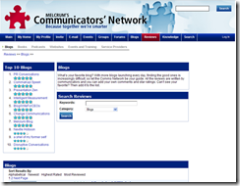Let it never be forgot
That there once was a spot
That for one brief shining moment
Was known as Camelot.
– from the musical Camelot
There has been a great conversation raging these past few months in the PR/marketing section of the blogosphere about whether or not “ghost blogging” is acceptable, i.e. the writing of a blog for someone by someone else (including by a PR firm). On the one side are those who don’t see any real difference between writing a blog entry for someone and writing a speech, press release (with quotes), annual report, etc. On the other side are those early adopters of social media and others who worship at the altar of Cluetrain who believe that ghost blogging is the polar opposite of what the “transparent” world of social media is all about. Blogs are just another communication vehicle with which we can assist our clients, say one side. Blogs are a departure from “corp-speak” and are meant to be in an authentic, human voice say the other side.
It’s been a fascinating discussion to watch, especially as many of the people who I now consider friends have weighed in on the issue. Shel Holtz and Neville Hobson have covered the issue on multiple FIR episodes. Terry Fallis and Dave Jones talked about it on their recent Inside PR #59. Bryan Person kicked off a whole thread with his mention of a “blog” ghost-written by Topaz partners, to which Topaz responded (and made some changes). Back in February, professional ghost writer Sallie Goetsch provided her interesting viewpoint. Chip Griffin talked about it in his Disruptive Dialogue podcast. Mitch Joel just recently wrote excellent posts here and here (this latest one today). Many, many others have written great posts. Folks like Doug Haslam from Topaz has been running around posting excellent comments on so many of those articles.  Regular “news” articles have appeared on the topic, such as this in Investors Business Daily: “Writing Blogs Can Be Hard, So Get ‘Help’“, which predictably set off more blog commentary. Even Scott Adams got into the story with Dilbert.
Regular “news” articles have appeared on the topic, such as this in Investors Business Daily: “Writing Blogs Can Be Hard, So Get ‘Help’“, which predictably set off more blog commentary. Even Scott Adams got into the story with Dilbert.
To me the most salient point was perhaps Dave Jones commentary in Inside PR #59 that while on one level “there are no rules” in blogging, “the rules today” are all about being transparent, and that rules change.
Transparency… today. But tomorrow?
Given that there are no real “rules”, let’s call them instead “conventions”. The “culture of the Blogosphere” is such that certain “conventions” are adhered to by those who participate. Those who don’t adhere to those conventions will be roundly chastised, attacked and otherwise shamed into conforming with the conventions of the culture.
This will, of course, change.
We’ve been here before.
If you go back to the late 1980s and early 1990s, there was an extremely strong “convention” among those of us using this bright shiny new thing called the “Internet” that there was to be absolutely no commercial activitity whatsoever on this here Internet. Anything that smacked of sales was absolutely verboten. Anyone who sent an email trying to sell something was chastised and might in fact be banned. Anyone who put up a gopher, ftp or (pre-1993) web server selling something was criticized. There was a view that it was our playground and we weren’t going to let any of those sleazy salespeople come in and deface everything with their grafitti.
Obviously, that changed. The rise of graphical browsers in 1993 along with the rise in consumer Internet services, faster modems, etc. all brought about a massive influx of people onto the Internet. And you know what?
They didn’t respect the conventions!
They put up websites with all sorts of advertisements. They sent email to (gasp!) hundreds or thousands of people! They harvested email addresses!!! The valiant defenders of the playground desperately attempted to fend off the immigrants, but there were just way too many and in time the battle was lost (and those defenders went off to go find other playgrounds to be in… at least until those, too, were overrun (think of the issues in Second Life around those who resent the new corporate presence)).
There were other conventions, too, that went by the wayside (in many cases as the technical restriction that created the convention ceased to be relevant). Consider these:
- It used to be considered extremely rude if your e-mail “signature block” (aka “sig”) was longer than 3 or 4 lines, and a 1 or 2 line sig was considered best. Look at sigs today! Often many lines… with graphics… animated icons and images… and so much more.
- It was once the convention that you should never, ever, ever send an email with an attachment larger than 100 Kbytes. That’s long gone as it’s now pretty routine to get multi-megabyte file attachments.
There’s many more, but the point is… cultural conventions evolve.
I definitely count myself among those who enjoyed Cluetrain and who revel in this world of social media primarily because of the authenticity… because of the “human” voices… because of the conversation that occurs outside the traditional stilted language of corp-speak. I believe in the power of blogs and podcasts to “humanize” subjects and even people… to let us know them in all their humanity, warts and all. I believe in the power of the authentic conversation. For all those reasons, I do see ghost-written blogs as unnatural.
But I also expect ghost blogs to become quite normal… for one simple reason:
We have succeeded.
Blogs are no longer dismissed as trivial online diaries kept only by people who want to talk about their cats. They are a serious and viable way to communicate directly. They are increasingly thought of (if not yet used) as part of the regular toolbox of corporate communication vehicles. Oh, yes, and by the way… in the Age of Google when Search is king, blogs seem to get good “Google-juice”. So you’re seeing the “I need a blog to be competitive” syndrome kicking in, and gee, since the tools are so easy to use, basically anyone can start up a blog. And so you’ve had so many new people entering the blogosphere and I expect that we’ll see even more as the tools become increasingly easier and easier. And you know what?
They won’t respect the conventions!
CEOs who want a blog but don’t seem themselves having the time will simply have a staff person do it. Companies who want a blog will just hire a firm to do it… just look at the number of companies already out there today who will “provide content for your blog” if you want them to do so. Those blogs will even “sound” human… just as good speechwriters today can create speeches in the style of the speaker, so too will ghost bloggers take on the style of the blog “author”. Blogs, podcasts, wikis, etc. will just be part of the communication plan… and in many cases will sadly spew out the same bland corporate drivel that caused so many of us to celebrate the changes brought so far by social media.
I hold onto the perhaps vain hope that those blogs, podcasts and other vehicles that do speak with “authentic” human voices will rise to the top. I’d like to hope that those CEOs who wade into the fray using their own words and writing their own text will get more attention (and see greater success) than those whose words are massaged through umpteen rounds of internal approvals and editing. I’d like to hope that the public conversations that can be had directly between companies and their customers will foster greater transparency and openness.
We’ll see. Does “social media” truly represent a shift toward transparency and “authenticity”? Or is it still too early to tell? Will the established conventions hold? Or will they be simply trampled upon by those newly arrived? How long will the defenders of the conventions be able to hold out? Will they be successful in converting the masses? Or will they have to retreat to some other place where transparency and authenticy can reign? (At least until it is discovered.)
Stay tuned… the story is being written all around us.
 In getting caught up on some listening to “For Immediate Release“, I noted that back at the beginning of the month, Shel & Neville launched the “FIR Forum” as a way to encourage conversations among FIR listeners. They tried this first with the discussion forums over on a Facebook Group, but, like most Facebook Groups I’ve seen, those forums hardly ever got used. So now they are trying it with what seems to be directly-hosted forum software. It’s not behind any walls… anyone can read the posts *without* registration. Anyone can register and join in the conversation. We’ll see how it goes!
In getting caught up on some listening to “For Immediate Release“, I noted that back at the beginning of the month, Shel & Neville launched the “FIR Forum” as a way to encourage conversations among FIR listeners. They tried this first with the discussion forums over on a Facebook Group, but, like most Facebook Groups I’ve seen, those forums hardly ever got used. So now they are trying it with what seems to be directly-hosted forum software. It’s not behind any walls… anyone can read the posts *without* registration. Anyone can register and join in the conversation. We’ll see how it goes! Jeremiah Owyang continues to demonstrate today why Forrester hired him with a great (and lengthy) post called “
Jeremiah Owyang continues to demonstrate today why Forrester hired him with a great (and lengthy) post called “



